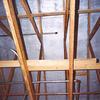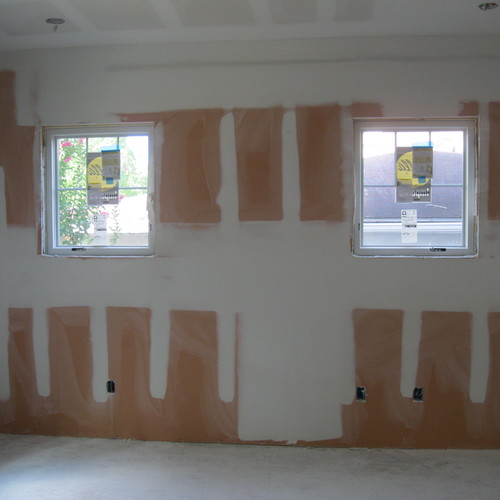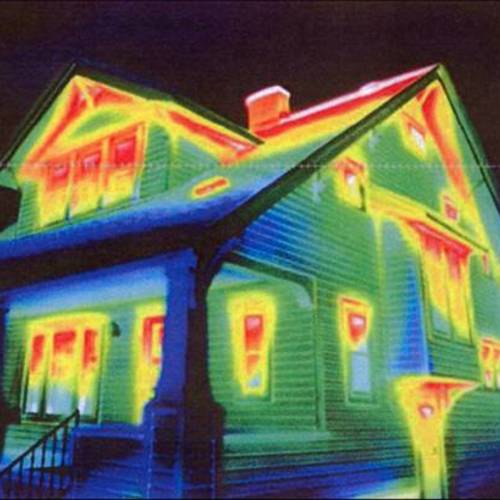
Image Credit: Lo/Mit-II
It’s time to sell some green upgrades this year, and this blog series is going to show you several ways I have “sold” them in the past. I put “sell” in quotes because I prefer to look at it like I show folks their options and they “buy” the one that’s right for them. So, this series will include, but not be limited to, selling attic ventilation, insulation, tankless water heaters, PEX plumbing, WaterSense plumbing fixtures, and radiant barrier roof decking. When not spec’d, all are options we have offered as part of building a new home or remodeling an existing home. By the way, these are never stand-alone projects we would do for anybody but a past client. So, let’s start selling radiant barriers for the attic!
First, I tell clients how they can benefit from a radiant barrier on their home and then tell them which product I prefer. I do not overwhelm them with building science or Ross Perot-style graphs showing the money they will save. I just flat out tell them a radiant barrier on the bottom of the roof deck is a no-brainer because it will make their attic cooler. Not cool, just cooler. I tell them that’s why I have one at my home and office, and then I explain how radiant barriers work according to the GBA Product Guide:
HOW TO SELL GREEN UPGRADESPart Two: Tankless Water HeatersPart Three: Energy AuditsPart Four: Exhaust FansPart Five: Electrical ImprovementsPart Six: Better InsulationPart Seven: A Few Small Things
“When they face a heat source, radiant barriers work by reflecting heat. When faced away from a heat source, radiant barriers function primarily by virtue of their low emissivity. This means that the surface does not radiate heat well. A radiant barrier surface on roof sheathing, for example, heats up from the sunlight striking the roof, but that heat energy is not readily emitted into the attic space—so that attic remains cooler. This is why the radiant barrier seems to ‘reflect’ heat back out of the building.”
Depending on the radiant barrier paint or foil product, it is not unusual to see radiant energy transfer reductions of 70% to 80%. That’s why down here in the South, where reducing cooling loads in homes is one of our largest concerns, it is so easy for me to feel evangelical about the importance of getting a radiant barrier into my client’s home.
That was it. That was my big sell. Did you miss it? No big building science charts. No estimated annual energy savings. No predictions for dollar amounts cut from energy bills. I just tell clients it is going to make their attic cooler and more comfortable. And anything they can do to reduce the heat load pounding down out of their attic into their home makes sense. But remember, these are not insulating paints, so don’t oversell this stuff. For a good primer on what to avoid when selling radiant barrier paints, visit Martin Holladay’s recent blog.
Our painter supplies the paint; I don’t. We take his turnkey price and mark it up 30% to 50% depending on the home, how crowded the attic is, and the size of the other work we have under way in the home already. Assuming nobody falls through the attic floor and into the house, it’s pretty simple work and quite easily managed by your superintendent.
If the house is on a heavily shaded lot, I tell them to skip the radiant barrier paint (and skip the solar PV, too, since it makes no sense cutting down good trees to get sunlight on the roof). But if the house has a large portion of the roof exposed to sunlight 12 hours a day during most of the year, as many in the Gulf Coast do, then a radiant barrier is a critical component of a high-performance, cooler attic.
By the way, yes, most foils have higher energy transfer reductions than the paints, but I still recommend the paints over the foils. In most attics it is virtually impossible to get 100% coverage with the foils because it is so difficult to get in the nooks and crannies of the attic for the installation. But with extensions and different spray tips, it is quite easy to get 100% coverage with the paints. Plus, the paints last longer without falling and tearing, they are more durable, and they look better. And no, it is never cost-effective to strip down an existing roof to replace the roof decking with a roof decking that has a radiant barrier laminated to the bottom of it. Radiant barrier roof decking is typically only cost-effective for new homes or room additions, and in those applications we include them standard.
Since a radiant barrier is only one of three parts of a high-performance attic here in the South, we’ll look at how to sell the other two components—attic ventilation and insulation—soon.
Weekly Newsletter
Get building science and energy efficiency advice, plus special offers, in your inbox.















11 Comments
Really...A Paint?
I have a hard time believing that a paint can hive high reflectivity. Have you had good luck with these products? Do you have a particular brand that you like and do they have literature explaining the emissivity? Most of the paints I’ve seen always refer to the special NASA technology they use which is when I typically stop paying attention.
I know prices vary per region, but do you mind sharing ballpark price per square foot for turn key paint vs. foil? We typically bid the foil by the job rather than the square foot and sometimes it ends up pretty pricey, could foam the attic for about the same price (which is what we are often being compared to).
Thanks for the article on radiant barriers. I’ve had many discussions with different weatherization experts and most have always told me it does not matter how hot it is in your attic as long as you are air sealed well and have enough insulation but common sense and experiencing radiant barriers always told me otherwise. Looking forward to the follow up articles.
There is no such thing as radiant barrier paint
Michael,
Your blog refers to "radiant barrier paint" -- a product that does not exist.
By definition, a radiant barrier must have a surface emittance less than or equal to 0.1. No paint has yet been invented that meets this definition, although some paints can be legally sold under the label of “radiation control coatings,” a category requiring an emissivity rating of 0.25 or less. However, many paints sold as "radiant barrier paints" or "insulating paints" fail to meet even this less stringent emissivity rating.
The Federal R-Value Rule tightly regulates contractors who make claims about the thermal performance of building materials. Although the law is poorly enforced, it's possible that a lawyer would interpret your claim that there is such a thing as "radiant barrier paint" to be a violation of the Federal R-Value Rule. It's best to stay away from bogus claims like this to keep yourself out of trouble.
"Selling"
Michael
I see you are in Houston and a LEED builder, I also build in Houston. I am considering starting a LEED spec home and interested in some marketing (or building) tips. I am using a local energy consultant (Clayton Farmer) to advise me on the process. Also, what is your opinion of spray foam in our climate.
Allan
Spray Foam
Michael
In my previous post my question about your opinion on spray foam in the Houston climate relates to spraying it all the way to the ridge and creating a non-vented attic.
Allan
Barriers and Climate
You speak of these barriers in your gulf coast region. What about other climate zones? When do you move to something else?
Everything I've read requires a space above the radiant barrier. Where is the space when you paint the roof deck? Where is the space when you install a foil package on the top of the roof deck below the shingles?
Lots to address here
My favorite product is from Sherwin Williams and it is called E-Barrier Reflective Coating. According to their website http://www.sherwin-williams.com/pro/products/ebarrier_reflective_coating/ "it was developed to address the demand for more energy efficent homes and buildings. It reflects radiant heat to keep structures cooler in the summer and warmer in the winter." It is the only paint product we have ever used. When I sprayed it to the bottom of my roof decking in my own office (after I gutted the room) I felt the temperature drop as I was applying it.
According to the GBA "when they face a heat source, radiant barriers work by reflecting heat. When faced away from a heat source, radiant barriers function primarily by virtue of their low emissivity, which reduces the amount of heat that radiates from them. Radiant barrier products can be foil-faced kraft paper, foil-faced polyethylene film, foil facings on rigid insulation or wood-fiber sheathing, or aluminized paints. If the radiant surface is touching another material it won't work--an air space is required on at least one side of a radiant barrier in order for it to function as designed." In the case of after market foils and paints that air space is below the product facing the attic interior. Same goes with the rb decking-it needs to face down into the attic, not up against the shingles. If you install spray foam against the bottom of a roof with a radiant barrier, you have no air space and you will not get the benefit of the barrier.
Martin my bad on the terminology. Radiant barrier paint is a term that does get thrown around loosely and is techically inaccurate. Even Sherwin Williams refers to it as a reflective coating. And of course we never refer to it as an insulating paint. Green building requries us to watch are performance claims even more so than otherwise so thanks for the reminder. Nonetheless, when properly applied they do reflect the heat and they do keep our attics cooler here in the south. I have no experience in northern climates but have no reason to believe their claims of keeping the attic warmer in the winter are not valid..
Do they justify the cost? It depends on the cost and we do not price it per square foot. Specialty contractors price it by the foot but for us it is simple time and materials. A painter and a helper can do any almost any empty attic in a day. We just add it to their scope when they are doing other painting on site at the time so they do not have to make a special trip.
Finally, for Allan, I know Clayton Farmer very well and would be pleased to help advise you or him on your LEED home. Send me an email directly. Spray foam down here will work very well with some caveats. Clayton or I can advise you on them but they are done every day here in the Houston area.
More unsolicited advice
Michael,
Calling this paint a "reflective coating" is much better than the false claim that it is a radiant barrier paint.
However, studies of reflective coatings have shown that this Sherwin-Williams product does NOT meet the ASTM standard for radiation control coatings -- and I'm talking about the low threshold of 0.25 emissivity, not the more stringent radiant-barrier threshold of 0.1 emissivity. Its emissivity is just too high -- it's been tested at 0.36. I think you should find a painting contractor who uses a better product.
If you want to offer your clients an effective reflective coating, why not choose one that meets ASTM's low-bar standard? Better choices are Radiance E025, Heat Bloc 75, Lo/Mit-1, Lo/Mit-2, Lo/Mit-II Max, or Heat Bloc-Ultra.
For more information, see
http://www.rimainternational.org/technical/ircc.html
Martin tell us more
Great great posts all. Martin, What info can you find or share about the value of spraying a good paint here in the great white north to reflect back our heat loss during cold weather?
Unsolicited? NOT!
We blog, we solicit. No worries there Martin. Thanks for the contribution and the recommendations you included.
Response to AJ
AJ,
There is no evidence that painting the underside of roof sheathing lowers utility bills in northern states.
Michael
Thanks for that confirmation about Clayton Farmer and as I get into this LEED process I may contact you for advice.
Allan
Log in or create an account to post a comment.
Sign up Log in